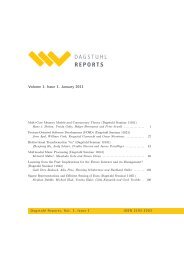Complete problems in the counting hierarchy - DROPS - Schloss ...
Complete problems in the counting hierarchy - DROPS - Schloss ...
Complete problems in the counting hierarchy - DROPS - Schloss ...
You also want an ePaper? Increase the reach of your titles
YUMPU automatically turns print PDFs into web optimized ePapers that Google loves.
372 Monomials <strong>in</strong> arithmetic circuits<br />
summand yields a unique monomial. This means that <strong>the</strong>re are no cancellations, so that<br />
per(A) is <strong>the</strong> number of monomials <strong>in</strong> per(B).<br />
The problem is now that no small circuits for <strong>the</strong> permanent are known and thus per(B)<br />
is not a good <strong>in</strong>put for ML-CountMon. But because <strong>the</strong>re are no cancellations, we have<br />
that det(B) and per(B) have <strong>the</strong> same number of monomials. So take a small circuit for<br />
<strong>the</strong> determ<strong>in</strong>ant (for <strong>in</strong>stance <strong>the</strong> one given <strong>in</strong> [21]) and substitute its <strong>in</strong>puts by <strong>the</strong> entries<br />
of B. The result is a circuit C which computes a polynomial whose number of monomials<br />
is per(A). Observ<strong>in</strong>g that <strong>the</strong> determ<strong>in</strong>ant, and thus <strong>the</strong> polynomial computed by C, is<br />
multil<strong>in</strong>ear completes <strong>the</strong> proof. ◭<br />
Acknowledgements We would like to thank Sylva<strong>in</strong> Perifel for helpful discussions. The<br />
results of this paper were conceived while <strong>the</strong> third author was visit<strong>in</strong>g <strong>the</strong> Équipe de Logique<br />
Mathématique at Université Paris Diderot Paris 7. He would like to thank Arnaud Durand<br />
for mak<strong>in</strong>g this stay possible, thanks to fund<strong>in</strong>g from ANR ENUM (ANR-07-BLAN-0327).<br />
The third author would also like to thank his supervisor Peter Bürgisser for helpful advice.<br />
References<br />
1 E. Allender, R. Beals, and M. Ogihara. The complexity of matrix rank and feasible systems<br />
of l<strong>in</strong>ear equations. Computational Complexity, 8(2):99–126, 1999.<br />
2 E. Allender, P. Bürgisser, J. Kjeldgaard-Pedersen, and P. B. Miltersen. On <strong>the</strong> Complexity<br />
of Numerical Analysis. SIAM J. Comput., 38(5):1987–2006, 2009.<br />
3 E.W. Allender and K.W. Wagner. Count<strong>in</strong>g hierarchies: polynomial time and constant<br />
depth circuits. Current trends <strong>in</strong> <strong>the</strong>oretical computer science: essays and Tutorials, 40:469,<br />
1993.<br />
4 S. Arora and B. Barak. Computational complexity: a modern approach. Cambridge University<br />
Press, 2009.<br />
5 P. Bürgisser. <strong>Complete</strong>ness and reduction <strong>in</strong> algebraic complexity <strong>the</strong>ory, volume 7. Spr<strong>in</strong>ger<br />
Verlag, 2000.<br />
6 P. Bürgisser. On Def<strong>in</strong><strong>in</strong>g Integers And Prov<strong>in</strong>g Arithmetic Circuit Lower Bounds. Computational<br />
Complexity, 18(1):81–103, 2009.<br />
7 Zhixiang Chen and B<strong>in</strong> Fu. Approximat<strong>in</strong>g multil<strong>in</strong>ear monomial coefficients and maximum<br />
multil<strong>in</strong>ear monomials <strong>in</strong> multivariate polynomials. In COCOA (1), pages 309–323, 2010.<br />
8 Zhixiang Chen and B<strong>in</strong> Fu. The Complexity of Test<strong>in</strong>g Monomials <strong>in</strong> Multivariate Polynomials.<br />
In COCOA, pages 1–15, 2011.<br />
9 H. Fournier, G. Malod, and S. Mengel. Monomials <strong>in</strong> arithmetic circuits: <strong>Complete</strong> <strong>problems</strong><br />
<strong>in</strong> <strong>the</strong> count<strong>in</strong>g <strong>hierarchy</strong>. ArXiv e-pr<strong>in</strong>ts, October 2011.<br />
10 M. R. Garey and D. S. Johnson. Computers and Intractability: A Guide to <strong>the</strong> Theory of<br />
NP-<strong>Complete</strong>ness. W. H. Freeman, 1979.<br />
11 F. Green. On <strong>the</strong> Power of Determ<strong>in</strong>istic Reductions to C=P . Theory of Comput<strong>in</strong>g<br />
Systems, 26(2):215–233, 1993.<br />
12 J. Hammond. Question 6001. Educ. Times, 32:179, 1879.<br />
13 L.A. Hemaspaandra and M. Ogihara. The complexity <strong>the</strong>ory companion. Spr<strong>in</strong>ger Verlag,<br />
2002.<br />
14 M. Jansen and R. Santhanam. Permanent Does Not Have Succ<strong>in</strong>ct Polynomial Size Arithmetic<br />
Circuits of Constant Depth. In ICALP, pages 724–735, 2011.<br />
15 V. Kabanets and R. Impagliazzo. Derandomiz<strong>in</strong>g Polynomial Identity Tests Means Prov<strong>in</strong>g<br />
Circuit Lower Bounds. Computational Complexity, 13:1–46, 2004.<br />
16 N. Kayal and C. Saha. On <strong>the</strong> Sum of Square Roots of Polynomials and related <strong>problems</strong>.<br />
In IEEE Conference on Computational Complexity, 2011.













